"People have had it with the smells and verrucas from indoor pools" says Thames Baths founder
Interview: a Kickstarter campaign has launched to fund a floating swimming pool for London's River Thames. According to Studio Octopi architect and project co-founder Chris Romer-Lee, the city is experiencing an outdoor swimming revolution.
"Indoor pools have had their day and there's a bit of a return back to the outdoors," said the architect. "There's definitely a demand for outdoor swimming. People have had it with the smells and the verrucas from indoor pools."

Romer-Lee and colleague James Lowe, who together run London architecture office Studio Octopi, are behind the Thames Baths initiative – a project that aims to rebrand London's waterway as a hub for swimmers through the construction of floating pools.
"People are really intrigued about getting into the water," Romer-Lee told Dezeen. "It's very similar to going in the sea – it's dangerous if you do stupid things, but if you respect the waterways then you're fine."
The team's current proposal is for a lido on the Victoria Embankment featuring two pools – a 25-metre lap pool and a training pool. Both will be filled with Thames water, filtered to ensure it is always clean enough to swim in.
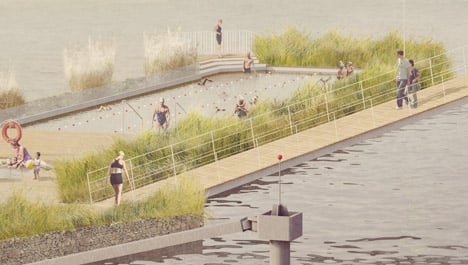
The long-term goal is to create baths filled with the moving tidal waters of the river. Romer-Lee believes this will be possible once construction has completed on the Thames Tideway Tunnel, the so-called super sewer set to upgrade London's 150-year-old waste system and prevent sewage overflowing into the water.
"The Thames has a very long history of swimming, and actually there were various floating baths on the Thames in the 1870s," said Romer-Lee. "The only reason why our generation has a phobia of the Thames is because we're told by parents and grandparents that the place is poisoned and an open sewer."
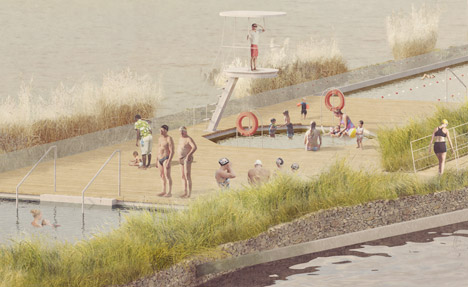
"Whereas the reality is that the Thames is actually a lot cleaner than we're led to believe," he continued. "Yes it has bad days when the sewers overflow. But in between those days the water is in amazingly good condition. All the brown you see is just the silt from the riverbed."
Studio Octopi unveiled its first Thames Bath proposal in 2013. Romer-Lee came up with the idea after a holiday spent swimming in Lake Zurich. "I thought, if the Swiss are prepared to jump into a green slimy lake, then surely Londoners are prepared to jump into the Thames," he explained.
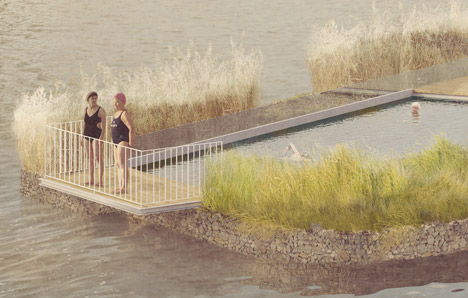
However, with the super sewer not due to complete until 2023, the architects developed a solution more achievable in the short term. "We wanted a bath that could be built in two years' time not in 10 years' time," said Romer-Lee.
The Kickstarter campaign is seeking £125,000, a fraction of the £11 million required to build one pool. The main aim is to garner support for the project from Londoners – Romer-Lee said he wants it to be an affordable place where children learn to swim, rather than exclusively for city workers.
"I think it's really, really important that it's not another London Eye," he said. "Some of the criticism we've had is that it will be just another highly priced tourist attraction, but that's absolutely what we don't want to do. The long term success of this actually is more to do with making it a community asset, something with a little bit of heart, and no Coca-Cola branding either."
Read on for the interview in full:
Amy Frearson: How did the Thames Baths project come about?
Chris Romer-Lee: I was on holiday in Zurich with the family and we were actually swimming in Lake Zurich, which has amazing facilities all around the lake catering for different sort of demographics, and there were an amazing collection of 1930s swimming baths all around the edge of the lake. At that moment I received a tweet asking if we wanted to enter a competition seeking future ideas for the Thames. I was literally just about to leap into a green slimy lake and I thought, if the Swiss are prepared to jump into a green slimy lake, then surely Londoners are prepared to jump into the Thames? It was that simple.
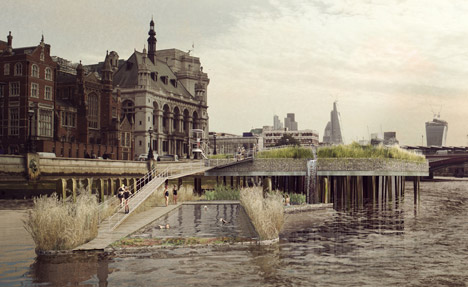
When I got back to London I realised that the Thames has a very long history of swimming, and actually there were various floating baths on the Thames in the 1870s, with perhaps the most famous one at Charing Cross. And it began to make a whole series of things drop into place – that the only reason why our generation doesn't swim in the Thames, doesn't go near the Thames, and has a phobia of the Thames is because we're told by parents and grandparents that the place is poisoned and an open sewer. Whereas the reality is that the Thames is actually a lot cleaner than we're led to believe. Yes it has bad days when the sewers overflow. The sewers are at capacity, so two millimetres of rainwater can bring raw sewage out of the overflows at various points on the river and pollute the water. But in between those days the water is in amazingly good condition. All the brown you see is just the silt from the riverbed.
To find out more, I met up with Caitlin Davies, who was midway through a book called DownStream: A History and Celebration of Swimming the River Thames, which has now just been released. She told me that it had all gone wrong in 1957 when the river was declared biologically dead – that was the low point. Since then, things are so much better.
That was reinforced last summer when I was walking along the Victoria Embankment and bumped into two retired gentlemen fishing off the embankment just by Temple Station. They said they couldn't believe how clean the water was now and the amount of fish they were pulling out of it: huge sea trout and an abundance of freshwater shrimps. They said they hadn't seen it like this in at least 40 years. So it all goes to prove that the condition of the water really isn't that bad.
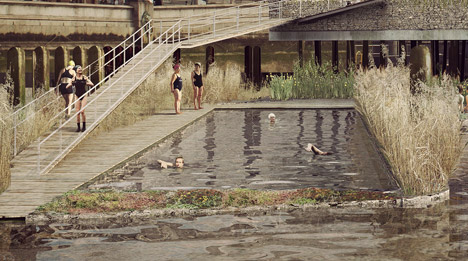
That said, the sewage overflows are still a problem, but those are being dealt with to a certain extent by the Thames Tideway Tunnel. Whether that's the right solution or not is a different conversation, but the hope is in seven years' time, when the sewer is finished, we will have a river that is clean enough to swim in all the time.
Amy Frearson: So tell me about your proposals.
Chris Romer-Lee: We first came up with this proposal where you could actually swim in the river water in a sunken bath, a sort of floating lido that just sat below the river surface, so it got rid of the currents and the danger of actually swimming in the river and you were in a protected, semi-submerged pool. That was in 2013.
It was so well received and there was so much press around it that James and I here at Studio Octopi thought we should give it another little push. We released the next image in August 2014, which was the sort of floating pontoon version. The difference being that we wanted a bath that could be built in two years' time not in 10 years' time – when the sewer is finished.
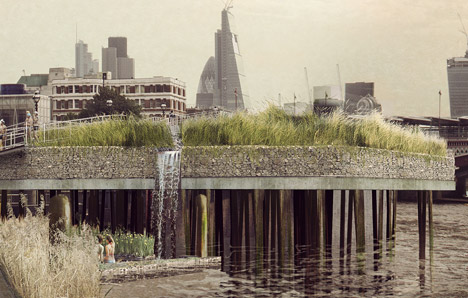
To do that we had to separate the water in the pools from the water in the river, and we did that by having two pools sunk into a pontoon. We worked out that we could take water from the river, pass it through the reed beds around the outside of the pontoon and then, through a German filtering system underneath the decking, fill up the pools with that water and close the system off. It's a closed system – once you've filled up the pools with that water you close it off, and you treat the water. And so you have a natural pond made from Thames water that can be gently warmed to about 18 degrees without needing any chemicals in it at all. So it's a kind of natural swimming pond. It's as close to swimming in the river safely that one can get.
Amy Frearson: How did the plans start to move towards reality?
Chris Romer-Lee: One of the most amazing things has been the amount of emails I've had from people from all over the world offering to help. Eventually we chose a strategist from a London agency to help us work out how to get the thing built. The problem with architects is we have a terrible habit of never looking beyond the end of our noses. He arrived and said: "Yes it can work at Victoria Embankment, but why can't it work in Leicester in the River Soar, why can't it work in the Trent, and then why can't it work on the continent or all the way around the world?" It was just brilliant to hear.
So we have started using crowdfunding as one of three routes to funding the whole project. It doesn't have to be a heavily branded building covered in logos, we think it can be a much quieter affair. We've also started conversations with other government sporting organisations and swimming brands to see how we can begin to pull together enough money to actually make this happen, and so far it's all good.
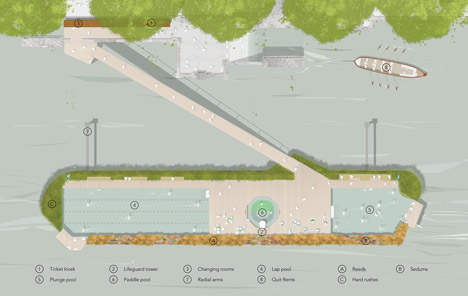
The reason for doing the crowdfunding isn't actually about the sums of money we're hopefully going to raise – £125,000 is small compared to the £11 million budget to get this thing in the water. But the beauty of the Kickstarter thing is the community one builds around an idea.
But we also want Londoners to buy into the idea. We don't want a situation where we're forcing a floating pool on Londoners when they don't want it. But I think we can get people to re-engage with the Thames. It isn't just a poisonous waterway, it is London's largest public space and London's largest underused space as well.
Amy Frearson: Do you think there's a swimming revolution going on in London at the moment?
Chris Romer-Lee: There is. We also recently won a competition for a lido in Peckham, and a large developer has also approached us about another swimming bath in London. There's definitely a demand for outdoor swimming. People have definitely had it with the smells and the verrucas from indoor pools, although people will probably get verrucas in the outdoor pools as well! It's the smells and the heat. I think indoor pools have had their day and there's a bit of a return back to the outdoors. It doesn't always have to be heated to the Nth degree either, and I think that's kind of exciting. People are jumping into all sorts of waterways.
Membership for the Outdoor Swimming Society has gone through the roof in the last three years, because people are really intrigued about getting into the water. It's very similar to going in the sea – it's dangerous if you do stupid things, but if you respect the waterways then you're fine.
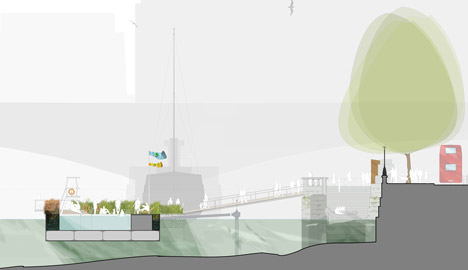
Amy Frearson: As well as the pools you've proposed at Temple and Blackfriars, have you identified any other sites where you'd like to build, either in London or elsewhere?
Chris Romer-Lee: Yes, we've got numerous locations on the Thames, probably four or five locations in the central section of the Thames. That's our primary objective at the moment. But outside that, for example, I was up in Leeds at the end of last year and they have some amazing waterways running through the city centre there so that's a possibility. But I think in all reality we have our work cut out at the moment, trying to keep up with the momentum of getting it in the Thames.
Amy Frearson: How far do you think you'll get with filtered pools before you can switch to using Thames water?
Chris Romer-Lee: The plan is to use river water when the super sewer is complete. Although I did mention that to the guys from Thames Tideway when we met them and they looked pretty horrified! I don't think anyone will know until the super sewer is built what exactly is possible. But what we're developing now is almost more interesting in a sense. It has a broader appeal of a greater scalability across the world, because there are so many waterways that are badly poisoned and inaccessible. If we can come up with something that actually resolves that issue then we've got more appeal.
Amy Frearson: Assuming you reach your Kickstarter target, what are the next steps?
Chris Romer-Lee: Let's say we hit our target by the end of May, that will allow us to do design development for the Victoria Embankment site at Temple, and/or another site that will remain nameless at the moment. We will choose one of those to take to planning, and we're confident that we can put in a planning application before the end of the year.
But the amount of work is quite staggering, just because of the number of reports and surveys, on top of all the drawings. We have to look at health and safety, and how we stop people jumping into the river and getting over-enthusiastic on a hot day. And also how a floating craft in a river protects itself from other rogue craft that may hit it. It would be an awful lot easier to put this into the ground, let's put it that way.
So that would get us into planning by the end of the year at the latest, and then we would be into 2016. I think our objectives are that, by the end of 2016, we have the pool up and running in central London.
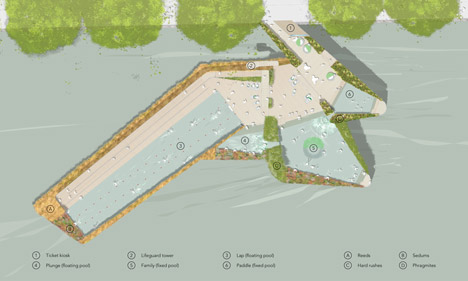
Amy Frearson: Have you experienced any negative reactions towards the project?
Chris Romer-Lee: You know what, surprisingly few. I think there is a concern that it's not always sunny in London, which is why we've gone down the gently warmed route, so we're hopefully going to use some renewable energy to heat the water.
We've established ourselves as a CIC – a community trust company – which is a sort of half charity, half limited company, so we will be able to run the baths like a charity, and apply for grant funding to get schools to use it for at least six months if not nine months of the year. I love the idea that kids are going to learn to swim in the river where their great, great grandfathers learnt to swim, as opposed to keeping it for city swimmers who go off to work and we're charging them £15 a swim. Obviously we're going to cap the price that reflects the nearest community pool. So we get as close to a community pool as feasibly possible, and the deck that surrounds the pool becomes very importantly a public space, so it won't cost to go onto the decked area. It will cost to swim but the decked areas will be an extension to the foreshore.
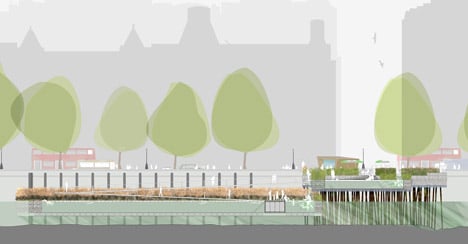
I think it's really, really important that it's not another London Eye. Some of the criticism we've had is that it will be just another theme ride for the Thames, another highly priced tourist attraction, but that's absolutely what we don't want to do. The long term success of this actually is more to do with making it a community asset, something with a little bit of heart, and no Coca-Cola branding either.
Amy Frearson: What other outdoor swimming venues do you rate?
Chris Romer-Lee: I'm longing to go to Copenhagen, trying to persuade the family to go there. But they know I want to go there for one reason. At the moment everything in our house is Thames Bath, and when the kids want to annoy me they say "We hate Thames Bath", which can be quite hard to deal with at times. But it's all very exciting.